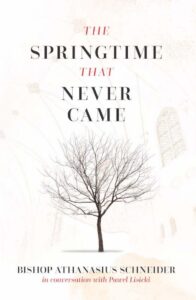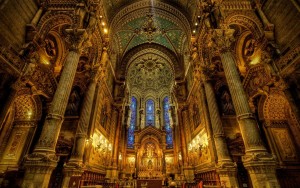Around the year 1300 in a small mountain village of northwest Spain called O’Cebriero, it was snowing hard on a cold winter’s day. The priest looked out into the blizzard, with waist-high drifts, and was glad – because it meant he could lock up the church without saying Mass. Sadly, this priest had lost his faith in the Real Presence of Christ in the Eucharist. He was about to lock the front door when he saw a single peasant farmer, trudging uphill in waist-deep snow, to the church. The priest was unhappy about this inconvenience, and when the farmer entered the Church, the priest sarcastically remarked, “Why did you come all this way for a piece of bread?”
The priest then proceeded to begin Mass, and much to his surprise, as he held up the Eucharist after the Consecration, it began to bleed. A statue of the Blessed Virgin in the church turned and bowed her head towards the altar, to recognize Who was present there. The priest’s faith was restored – and this Eucharistic miracle has been preserved in that church. I have been there, and have seen the statue of Mary, her head still bowing towards the tabernacle, where Her Son Jesus resides.
It does indeed take faith to believe that this small round Host which we receive at Mass is truly the Body and Blood of the Lord. How can we explain such a mystery, when our senses seem to tell us that it is just ordinary bread? Let’s take a deeper look at the Scriptures to see how we can understand the Real Presence of Christ in the Eucharist.
Jesus clearly says that He is the Bread of Life. But Jesus says that He is many other things that He only means symbolically – He calls Himself the Good Shepherd, the Vine, the Light of the World. Could He be using “Bread of Life” symbolically? Not if we look at the original Greek.
There are two Greek words for eating: “ephago” and “trogon”. Ephago simply means “to eat” and that can be used symbolically. We sometimes use “eating” symbolically in English when we say, “Let me chew on that idea for a while” or we say, “I need to digest that book.” Clearly we are meaning that symbolically. But the other word, “trogon”, is much more graphic – it means to chew, to gnaw, to rip with one’s teeth. It is a visceral, graphic verb that is never used symbolically. And it is this verb that Jesus uses in John 6 to describe what we must do! He says we must “trogon” His Flesh…we must literally put His Flesh between our teeth and consume Him!
This should gross us out a bit…because that was certainly the reaction of the Jews! Immediately after this Gospel, they start complaining loudly to one another, “How can this man give us His Flesh to eat?” Jesus doesn’t back down – actually He doubles down and says, “Unless you eat (trogon) the Flesh of the Son of Man and drink His blood, you have no life within you. For My Flesh is true food, and My Blood is true drink.” His listeners react with even greater disgust – and Jesus does not apologize. Finally, it says later on in John 6 that “many of his disciples returned to their former way of life and no longer accompanied Jesus” – they walked away because of this teaching! Does Jesus run after them and say, “No, wait, you misunderstand Me!”? No – He turns to His Apostles and says, “Will you also leave?” And Peter responds, “Lord, to whom shall we go? You have the words of everlasting life.” So Jesus teaches clearly, unambiguously that the Eucharist is truly His Flesh, that we must truly consume Him, and He is willing to lose followers over this teaching!
But then how do we explain the fact that it still looks like bread? Well, have you ever been to a restaurant or a fancy hotel and seen a flower display and thought to yourself, “I can’t tell if that’s real or not!”? You go up to it, look at it, maybe smell it, touch it…and sometimes you still can’t tell! Fake flowers are sometimes so realistic that your senses tell you they’re real flowers, while they are actually made of silk.
In the same way, in the Eucharist, our senses tell us one thing – but what it actually is is completely different. The great scholar St. Thomas Aquinas used the terms “accident” and “substance”. Accident means what something looks like, feels like, smells like, tastes like, etc – basically, our five senses. But “substance” is what something actually is. At every Mass, we begin with bread – it looks like bread, and it is bread. But at the point in the Mass called the “Consecration” when the bells are rung, we believe that a transformation happens. Aquinas called it “transubstantiation” – the substance of bread actually becomes the substance of Jesus Christ Himself, even though the accidents remain the same.
And I’m glad they do remain the same! I wouldn’t want to receive a jiggling, bleeding piece of flesh at Mass – it would be repulsive. So He hides Himself under the appearance of very common things – bread and wine – in order for us to approach Him without fear. But He desires to be so intimately united to us – not just spiritually, but physically as well since we are both souls and bodies – and so He desires to become our Food. Every other kind of food I eat becomes a part of my body; but in the Eucharist, I become more like Him.
When we stop and think about it, this is the most amazing miracle in the entire world. There is literally nothing that we can compare to it – a small wafer of bread, a small chalice of wine, when a priest speaks the words of Consecration over them, becomes the very Flesh and Blood of God Himself. May we approach this Eucharistic altar with awe and wonder; with souls cleansed of sin and aflame with love – for so great a gift and mystery as Christ’s Real Presence in the Holy Eucharist.
____
Originally published at The Cross Stands While the World Turns
Photo: Public Domain






